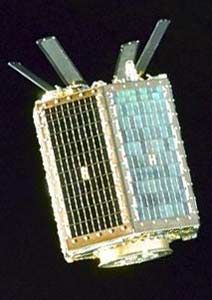
Home - Search - Browse - Alphabetic Index: 0- 1- 2- 3- 4- 5- 6- 7- 8- 9
A- B- C- D- E- F- G- H- I- J- K- L- M- N- O- P- Q- R- S- T- U- V- W- X- Y- Z
MightySat 1
 Mightysat 1 Credit: Manufacturer Image |
AKA: P97-2. Status: Operational 1998. First Launch: 1998-12-04. Last Launch: 1998-12-04. Number: 1 . Gross mass: 320 kg (700 lb).
MightySat was a United States Air Force Phillips Laboratory multi-mission, small satellite program dedicated to providing frequent, inexpensive, on-orbit demonstrations of space system technologies.
The MightySat payload was launched from the Shuttle via the Hitchhiker Ejection System, which was managed out of the Goddard Space Flight Center in Greenbelt, MD. The payload was deployed on flight day twelve.
The primary objective of the MightySat program was to provide on-orbit demonstrations of emerging technologies. Data from the mission was used to support decisions on the readiness of the tested technology for Air Force missions.
The Mightysat-1 payload was a non-retrievable spacecraft that would be deployed from the Space Shuttle Endeavour on STS-88. The MightySat payload had five advance technology demonstration experiments. The Advanced Composite Structure, which serves as the structure for the vehicle, had no command interfaces with the spacecraft. All relevant data on the structure would be captured in ground testing. The Advanced Solar Cell Experiment would test the performance of dual-junction solar cells comprised of Gallium Indium Phosphide layers atop a Gallium Arsenide (GaAs) layer. These dual junction cells provide more power than conventional GaAs cells. As a result, this advance in space power technology could be useful for power-intensive sensors in the future and small satellite missions which had power constraints.
The Microsystem and Packaging for Low Power Electronics (MAPLE) experiment was a demonstration of advanced microelectronics and electronics packaging techniques. The objective was to provide an on-orbit demonstration of the electronics in the space environment. The Shape-Memory Actuated Release Device (SMARD) payload would demonstrate a new class of low shock release devices. Release devices were used to separate satellites from launch vehicle adapters, or to deploy antennae, solar arrays, and sensor covers. Such devices offer reduced shock levels because the separation time was longer. They were low-cost and could be completely reset. Lastly, the objective of the Micro-Particle Impact Detector (MPID) experiment was to place as many detectors into space to provide indications of natural and man-made orbital debris.
The payload would be mounted in the orbiter bay 6 port location on a GSFC-provided HH ABA, with the MightySat 1 canister mounted in the forward position and the HH avionics mounted in the aft position.
After the payload bay doors were opened, the crew would activate the power and signal path to the HH carrier via the standard switch panel. The satellite would be ejected from the HH canister on Flight Day 12. MightySat 1 was spring-ejected at a minimum rate of 1.7 fps and requires an overflight of a specific location in Albuquerque, N.M. within 6 hours of deploy. Once ejection was complete, flight operations were complete for the satellite. Telemetry and command capability would then be via the Payload Operations Control Center (POCC) at GSFC.
The program manager for MightySat-1 was Lt. Barbara Braun from the Air Force Research Laboratory.
History/Background
MightySat 1 was the first flight of a U.S. Air Force (USAF) Philips Laboratory/Space Experiments Directorate ejectable technology demonstration platform. Four advanced technologies would be demonstrated on MightySat 1. These technologies include a composite structure, advanced solar cells, advanced electronics, and a shock device.
| Mightysat 1 (P97-2) Null |
Family: Military technology sat, Surveillance orbit, Technology. Country: USA. Launch Vehicles: Space Shuttle, Minotaur. Launch Sites: Cape Canaveral, Cape Canaveral LC39A. Agency: USAF, OSC. Bibliography: 2.
1998 December 4 - . 08:35 GMT - . Launch Site: Cape Canaveral. Launch Complex: Cape Canaveral LC39A. Launch Platform: MLP3. LV Family: Shuttle. Launch Vehicle: Space Shuttle.
- Mightysat 1 - . Mass: 320 kg (700 lb). Nation: USA. Agency: USAF. Manufacturer: McLean. Class: Technology. Type: Navigation technology satellite. Spacecraft: Mightysat 1. Decay Date: 1999-11-21 . USAF Sat Cat: 25551 . COSPAR: 1998-069C. Apogee: 395 km (245 mi). Perigee: 381 km (236 mi). Inclination: 51.60 deg. First flight of a USAF Philips Laboratory/Space Experiments Directorate ejectable technology demonstration platform. Four advanced technologies demonstrated, including composite structure, advanced solar cells, advanced electronics, and a shock device..
Back to top of page
Home - Search - Browse - Alphabetic Index: 0- 1- 2- 3- 4- 5- 6- 7- 8- 9
A- B- C- D- E- F- G- H- I- J- K- L- M- N- O- P- Q- R- S- T- U- V- W- X- Y- Z
© 1997-2019 Mark Wade - Contact
© / Conditions for Use